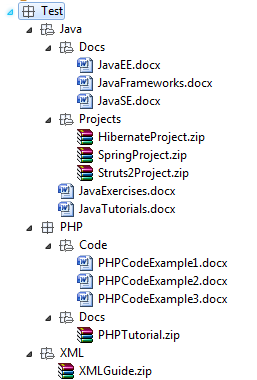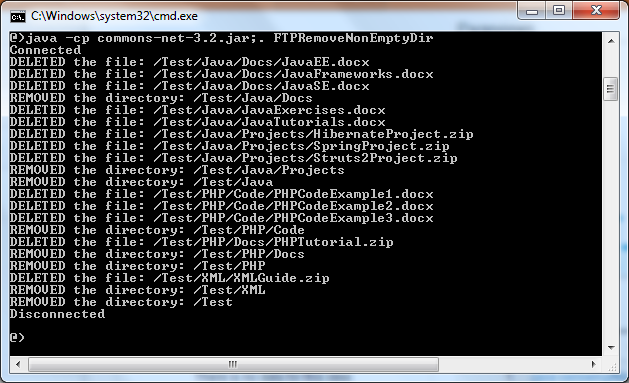Java FTP Remove a non-empty directory on server
- Details
- Written by Nam Ha Minh
- Last Updated on 19 July 2019 | Print Email
import java.io.IOException;
import org.apache.commons.net.ftp.FTPClient;
import org.apache.commons.net.ftp.FTPFile;
/**
* This utility class implements a method that removes a non-empty directory
* on a FTP server.
* @author www.codejava.net
*/
public class FTPUtil {
/**
* Removes a non-empty directory by delete all its sub files and
* sub directories recursively. And finally remove the directory.
*/
public static void removeDirectory(FTPClient ftpClient, String parentDir,
String currentDir) throws IOException {
String dirToList = parentDir;
if (!currentDir.equals("")) {
dirToList += "/" + currentDir;
}
FTPFile[] subFiles = ftpClient.listFiles(dirToList);
if (subFiles != null && subFiles.length > 0) {
for (FTPFile aFile : subFiles) {
String currentFileName = aFile.getName();
if (currentFileName.equals(".") || currentFileName.equals("..")) {
// skip parent directory and the directory itself
continue;
}
String filePath = parentDir + "/" + currentDir + "/"
+ currentFileName;
if (currentDir.equals("")) {
filePath = parentDir + "/" + currentFileName;
}
if (aFile.isDirectory()) {
// remove the sub directory
removeDirectory(ftpClient, dirToList, currentFileName);
} else {
// delete the file
boolean deleted = ftpClient.deleteFile(filePath);
if (deleted) {
System.out.println("DELETED the file: " + filePath);
} else {
System.out.println("CANNOT delete the file: "
+ filePath);
}
}
}
// finally, remove the directory itself
boolean removed = ftpClient.removeDirectory(dirToList);
if (removed) {
System.out.println("REMOVED the directory: " + dirToList);
} else {
System.out.println("CANNOT remove the directory: " + dirToList);
}
}
}
}Notice that the method removeDirectory() is using recursive algorithm, which invokes itself if the file being listed is also a directory. That allows the method to work with directory structure in any depth level (only limited to the memory).Here is a test program that connects to a FTP server, remove the directory “/Test” and disconnects from the server:import java.io.IOException;
import org.apache.commons.net.ftp.FTPClient;
/**
* This program demonstrates how to remove a non-empty directory on a FTP
* server, using Apache Commons Net FTP library.
*
* @author www.codejava.net
*
*/
public class FTPRemoveNonEmptyDir {
public static void main(String[] args) {
String server = "www.codejava.net";
int port = 21;
String user = "username";
String pass = "password";
FTPClient ftpClient = new FTPClient();
try {
// connect and login to the server
ftpClient.connect(server, port);
ftpClient.login(user, pass);
// use local passive mode to pass firewall
ftpClient.enterLocalPassiveMode();
System.out.println("Connected");
String dirPath = "/Test";
FTPUtil.removeDirectory(ftpClient, dirPath, "");
// log out and disconnect from the server
ftpClient.logout();
ftpClient.disconnect();
System.out.println("Disconnected");
} catch (IOException ex) {
ex.printStackTrace();
}
}
} NOTES:Remember to change the server address, username and password according to your own FTP account.Compile the utility class:javac -cp commons-net-VERSION.jar FTPUtil.java
Compile the test program:javac -cp commons-net-VERSION.jar;. FTPRemoveNonEmptyDir.java
java -cp commons-net-VERSION.jar;. FTPRemoveNonEmptyDir
Where commons-net-VERSION.jar is runtime library of the Apache Commons Net. You can download the latest distribution of this library here.Supposing the directory “/Test” on the FTP server we want to remove has the following structure: Then the program would produce the following output:
Then the program would produce the following output:
Related Java FTP Tutorials:
- Determine if a directory or file exists on FTP server
- Java FTP create directory example
- Java FTP example - Change working directory
- Remove an empty directory on a FTP server
- Rename file or directory on FTP server
Other Java FTP Tutorials:
- Connect and login to a FTP server
- Java FTP list files and directories example
- Java FTP file download tutorial and example
- Java FTP file upload tutorial and example
- Java FTP delete file example
- Java FTP example - Search for files and directories
- How to upload a directory to a FTP server
- How to download a complete folder from a FTP server
About the Author:
 Nam Ha Minh is certified Java programmer (SCJP and SCWCD). He began programming with Java back in the days of Java 1.4 and has been passionate about it ever since. You can connect with him on Facebook and watch his Java videos on YouTube.
Nam Ha Minh is certified Java programmer (SCJP and SCWCD). He began programming with Java back in the days of Java 1.4 and has been passionate about it ever since. You can connect with him on Facebook and watch his Java videos on YouTube.